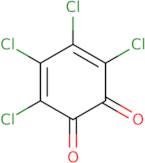
Product Information
- Tetrachloro-o-benzoquinone
- 3,4,5,6-Tetrachloro-1,2-benzoquinone
- 3,4,5,6-Tetrachloro-3,5-cyclohexadiene-1,2-dione
- 3,4,5,6-Tetrachloro-o-benzoquinone
- 3,4,5,6-Tetrachlorobenzoquinone
- 3,4,5,6-Tetrachlorocyclohexa-3,5-Diene-1,2-Dione
- 3,4,5,6-Tetrachlorocyclohexadiene-1,2-dione
- 3,5-Cyclohexadiene-1,2-dione, 3,4,5,6-tetrachloro-
- Isochloranil
- NSC 403503
- See more synonyms
- Tetrachloro-1,2-benzoquinone
- Tetrachloro-o-quinone
- Tetrachloro-ortho-benzoquinone
- Tetrachloroorthobenzoquinone
- o-Benzoquinone, 3,4,5,6-tetrachloro-
- o-Benzoquinone, tetrachloro-
Please enquire for more information about o-Chloranil including the price, delivery time and more detailed product information at the technical inquiry form on this page
Chemical properties
Technical inquiry about: 3D-FC00674 o-Chloranil
If you want to request a quotation or place an order, please instead add the desired products to your cart and then request a quotation or order from the cart. It is faster, cheaper, and you will be able to benefit from the available discounts and other advantages.





